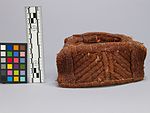łagakwame' (Head Ring)
About this object
History of use
Worn by Hamat’sa initiates. The initiate’s dance is considered by Kwakwaka’wakw people today to be the highest ranked ritual in the T’seka, or Red Cedar-Bark ceremony. It came to the Kwakwaka’wakw historically through marriage and warfare with their northern neighbours, the Wuikinuxv and the Heiltsuk. There are many differences in the way that families who have hereditary rights to this important privilege perform the dance, and in the songs and regalia they use, but common to all is the dramatic interpretation of the initiate’s experience of capture, return, and calming. In the dance of the Hamat’sa, a young person is possessed by the man-eating spirit, Baxbakwalanuksiwe’. Through the four stages of the dance the initiate is gradually returned to a normal, human state with the help of attendants, and through song and ritual. The cedar-bark regalia the initiate wears during this cycle is considered sacred.
Narrative
May have belonged to Willie Seaweed, if so was made by B. Scow's grandmother, who was married to Willie Seaweed (B. Scow, 1966).
Physical description
Thick head band of strips of cedar bark bound on diagonal angles with fine twisted cedar bark string. Lower edge of the band bound with fine twine. Four bundles of shredded bark wrapped in a covering of woven cedar bark string tied around the top edge of the band. Additional panel of bark similar in construction to the main band attached on one side. Inside of the band lined with cotton cloth.
Categories
Materials
